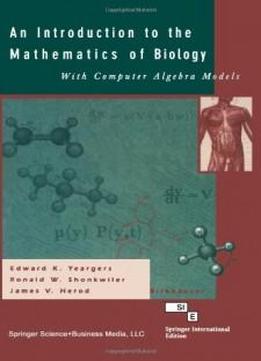
An Introduction To The Mathematics Of Biology: With Computer Algebra Models
by Edward K. Yeargers /
2012 / English / PDF
19.6 MB Download
Biology is a source of fascination for most scientists, whether
their training is in the life sciences or not. In particular, there
is a special satisfaction in discovering an understanding of
biology in the context of another science like mathematics.
Fortunately there are plenty of interesting (and fun) problems in
biology, and virtually all scientific disciplines have become the
richer for it. For example, two major journals, Mathematical
Biosciences and Journal of Mathematical Biology, have tripled in
size since their inceptions 20-25 years ago. The various sciences
have a great deal to give to one another, but there are still too
many fences separating them. In writing this book we have adopted
the philosophy that mathematical biology is not merely the
intrusion of one science into another, but has a unity of its own,
in which both the biology and the math ematics should be equal and
complete, and should flow smoothly into and out of one another. We
have taught mathematical biology with this philosophy in mind and
have seen profound changes in the outlooks of our science and
engineering students: The attitude of "Oh no, another pendulum on a
spring problem!," or "Yet one more LCD circuit!" completely
disappeared in the face of applications of mathematics in biology.
There is a timeliness in calculating a protocol for ad ministering
a drug.
Biology is a source of fascination for most scientists, whether
their training is in the life sciences or not. In particular, there
is a special satisfaction in discovering an understanding of
biology in the context of another science like mathematics.
Fortunately there are plenty of interesting (and fun) problems in
biology, and virtually all scientific disciplines have become the
richer for it. For example, two major journals, Mathematical
Biosciences and Journal of Mathematical Biology, have tripled in
size since their inceptions 20-25 years ago. The various sciences
have a great deal to give to one another, but there are still too
many fences separating them. In writing this book we have adopted
the philosophy that mathematical biology is not merely the
intrusion of one science into another, but has a unity of its own,
in which both the biology and the math ematics should be equal and
complete, and should flow smoothly into and out of one another. We
have taught mathematical biology with this philosophy in mind and
have seen profound changes in the outlooks of our science and
engineering students: The attitude of "Oh no, another pendulum on a
spring problem!," or "Yet one more LCD circuit!" completely
disappeared in the face of applications of mathematics in biology.
There is a timeliness in calculating a protocol for ad ministering
a drug.











